Art & Exhibitions
Rage, Obsession, and Sexual Misadventure Dominate at Trenton Doyle Hancock’s Studio Museum Survey
In Hancock's alternative art universe, the biggest villains are "Vegans."
In Hancock's alternative art universe, the biggest villains are "Vegans."
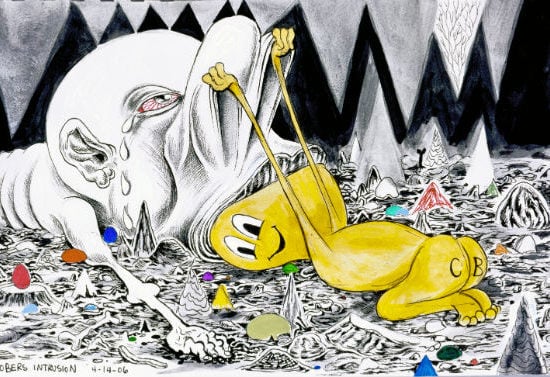
Raised to a family of African-American teachers and preachers in rural Paris, Texas, and trained at East Texas University and Philadelphia’s Tyler School of Art, Houston-based artist Trenton Doyle Hancock (b. 1974) makes work that is less “post-Black” than post-Earth, post-human, post-reality. It’s built around a personal cosmology forged from equal parts comic book lore, Biblical narrative, and offbeat art influences including Henry Darger, Philip Guston, and Gary Panter. The cool thing about the Studio Museum in Harlem’s just-opened Hancock survey (originally seen at the Contemporary Art Museum, Houston) is that it manages to give not just the taste of the amusing strangeness of his parallel universe, but draws that world back into the orbit of our own troubled one.
Full of willful repulsiveness and carefully cultivated adolescent (male) obsessions, Hancock’s works are not for every taste. It Came From Studio Floor (2002) consists of a series of large drawings depicting the deflating sexual misadventures of a fuck-up superhero, “Torpedoboy,” narrated by text painted directly on the gallery wall. Some phrases are accented with multicolored lettering, and in looking at them, it becomes clear that the free-associative story is assembled by stringing together belabored anagrams of the phrases, “Studio Floor:” “Do It Slow or F.U.,” “I Sold Ur Foto,” and so on.
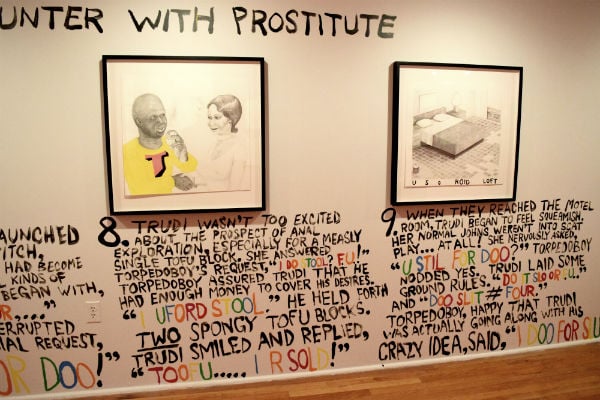
Detail of Trenton Doyle Hancock, It Came From Studio Floor (2002)
Photo: Ben Davis
Bye and Bye (2002), on loan from the Museum of Fine Arts, Houston, is a large, overflowing drawing showing hoards of animals—their bloodshot eyes providing the work’s only color—converging to worship the corpse of a mysterious creature whose skeleton appears like a gangly Christmas tree made of bones.

Detail of Bye and Bye (2002) Photo: Ben Davis
A host of other drawings, large and small, dwell on the activities of spidery, twisted gremlins, shown sticking funnels in their butts, operating menacing contraptions, and being generally freaky.
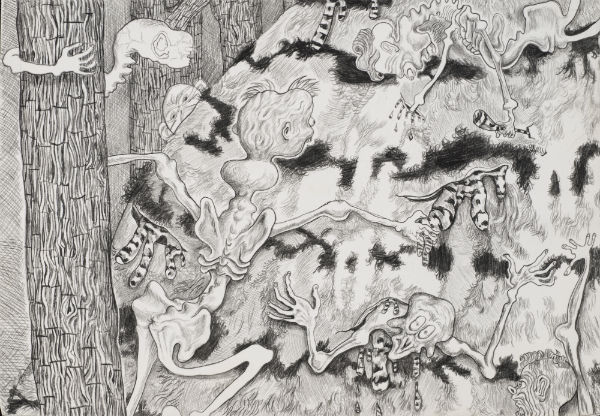
Trenton Doyle Hancock, Vegans Do Nasty Stuff (2002)
Photo: Courtesy the artist, James Cohan Gallery and Hales Gallery
The specifics of the Hancock cosmos are too involved, and have been too often recounted, to go over in complete detail here. They involve a Manichean battle between two races: the “Mounds”—gentle, roly-poly woodland creatures that are half-plant, half-animal, covered with striped black-and-white fur—and the “Vegans,” vile subterranean gremlins who eternally scheme to devour Mound-flesh.
To all this you might say: Really, vegans? And indeed, yes, Hancock’s evil Vegans are inspired, he says, by real vegans; specifically, by a couple he lived with during graduate school in the 1990s, whose self-righteous pronunciations about his diet apparently left a very, very bad impression on the developing artist.
If it seems strange to build an entire, epic artistic work on such an affront, I think the very disproportion is significant. My guess is that it only really makes sense if you view the tiff over eating habits as condensing a whole number of much, much bigger issues: his sense of being under scrutiny for his race and his rural Southern background; his vulnerability about his own body image; and through this, anxiousness about sex and self.
That Hancock’s “Mounds” have always been a kind of self-portraiture is likely clear to anyone paying attention. Their striped fur, for instance, evokes old-timey convict uniforms, insinuating consciousness about the targeting of black men by the criminal justice system. In this show, a recent series of bluntly grotesque self-caricatures have the main virtue of bringing Hancock’s animating insecurities to the surface more clearly, cartooning his own body as a Mound-like accumulation of rolls of dark flesh, trapped on an exercise treadmill in underground Vegan hell.
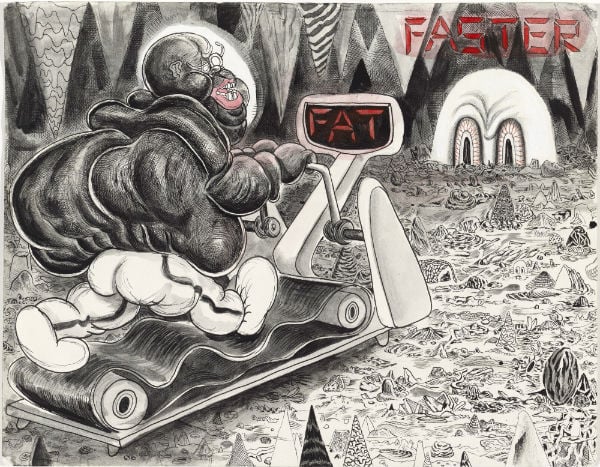
Trenton Doyle Hancock, Faster (2010)
Photo: Ben Davis
More endearing is a series of comic strips from Hancock’s student days at East Texas State, called Epidemic! This juvenilia confirms the artist’s underlying wit, coming off as a slightly more scabrous version of Gary Larson’s immortal cartoon series The Far Side. At least one, however, is genuinely important, reading as a veritable manifesto for the art that came after.
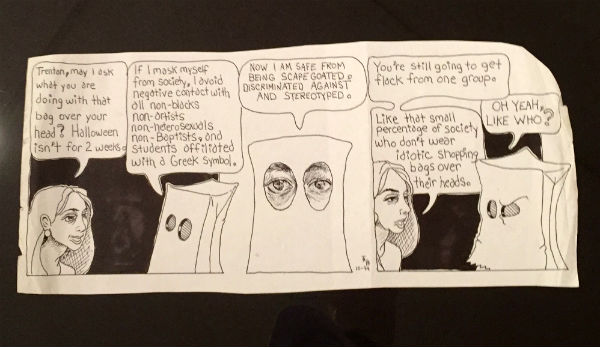
You can interpret this joke as presaging the entire grotesque mythopoesis of the Mounds vs. Vegans work. Like a mask that shields from being “scapegoated, discriminated against, and stereotyped,” Hancock’s fantasy narrative creates a defensive membrane through which he relates to the world, costuming real anxieties in absurd form.
Perhaps the burden of dealing with this absurdity is why, of late, Hancock has been moving away from his own mythology, declaring it played out. The most recent work at the Studio Museum is a series of 30 black-and-white acrylic-on-board works dating from 2014 called Step and Screw. (In its original Houston showing, this work was given much more emphasis as an installation shown in its own free-standing structure, lit by a bare light bulb.)

Step and Screw inherits the same fever-dream quality as Hancock’s previous art, but the frame of reference is different. Each panel consists of an illustration and a crudely incised caption; sometimes image and text correspond, sometimes they move out of sync. Each panel centers on a date, starting with 1878, pinning the panels to real history rather than fantastical history.
The narrative weaves together a variety of seemingly disconnected events: the life story of Ida B. Wells, campaigner against lynching who shares a name with an ancestor of Hancock; the history of Paris, Texas, Hancock’s hometown, starting with an infamous 1893 fairground lynching; the biography of Philip Guston, the artist whose cartoonish Klansmen have become a fundamental part of Hancock’s iconography.
These fragments, in turn, lead into confessional vignettes from the artist’s own life: his mother finding his stash of dirty magazines, and seeming most concerned that all the pinups were white; a college incident where he and another student published in the school paper criticism of campus fraternities, which retaliated by hosting an “‘Anti-Liebowitz-Hancock’ newspaper burning party” (proving that such organizations were as classy then as they are now.)
In the penultimate frame—dated from 2003, just after Hancock came into his own as an artist—a crowd of Guston-esque Klansmen surround a sweating cartoon Hancock, clad in superhero garb. They offer him a mask to wear—in fact, the paper bag from the long ago Epidemic! comic.
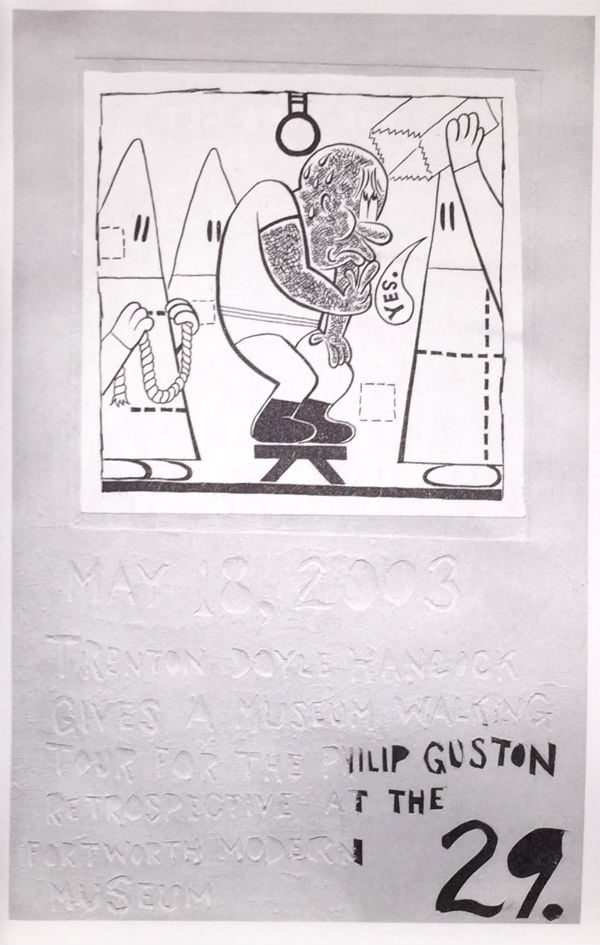
The entire Step and Screw project therefore comes to read as an attempt at a personal archeology of the artist’s own hang-ups and obsessions—and through them, of the masks that he has worn in his art.
Then there’s the final panel. It begins, “Will our hero get himself out of this one?” But then in the bottom half, a text straight-forwardly describes a July 21, 2009 confrontation in Paris, Texas over the acquittal of two white supremacists accused of dragging to death the African-American man Brandon McClelland.
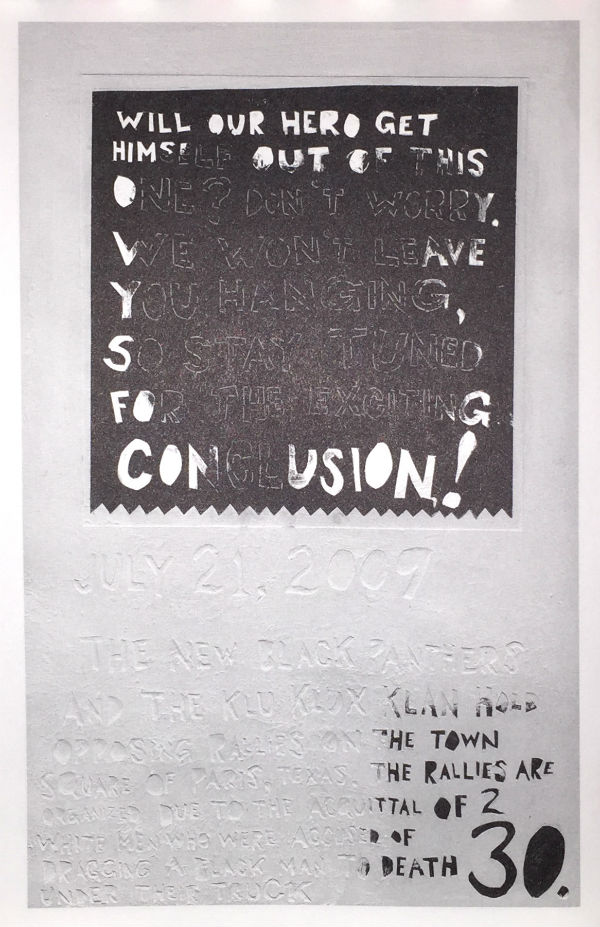
A quote attributed to James Baldwin, much-invoked of late, says that, “To be black and conscious in America is to be in a constant state of rage.” Hancock’s work reads as a kind of corollary: It suggests how a plunge into the unconscious might take on particular significance in an America where evidence of racism still crowds in on all sides, to keep the mind from being paralyzed by ambient outrage. It is, indeed, striking that Hancock’s art has had a particular natural kinship with all the paraphernalia of Freud’s unconscious: myth and fantasy, jokes, and free-associative wordplay.
If Hancock has in general swapped outrageousness for Baldwin’s radiant outrage, Step and Screw hints at a new synthesis of the two. And this show seems not just to be an essay on the fantastic, but a demonstration of how you might pass through fantasy to the painful world at hand.
“Trenton Doyle Hancock: Skin and Bones, 20 Years of Drawing” is on view at the Studio Museum in Harlem, New York, through June 28, 2015.